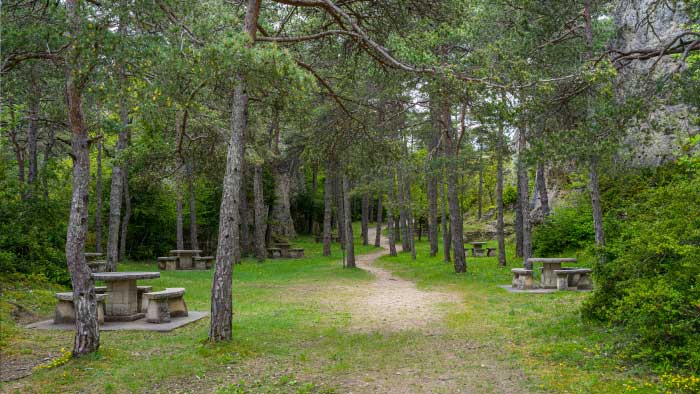Management & Protection
History
Until the end of the 1930s, the Cité de Pierres site was totally closed in with no access roads or tracks making it almost completely inaccessible except by a mule-track climbing up from the bottom of the Dourbie Gorge.
It was difficult to move around the site because of its steep topography and dense vegetation.
Only a few privileged individuals had been able to discover the site with the help of guides at a time where tourism within France was only just beginning and much finance was required for both the tourists themselves and for the construction of the necessary infrastructure.
Having already opened the Aven Armand up to the public in 1927, the ‘Société de l’Aven Armand’, itself founded in 1925, therefore decided to invest in Montpellier-le-Vieux at the end of the 1930s.
The aim was to male this ‘Cité des Pierres’ accessible to the general public, just as the society has done for Aven Armand, such that it could become a major contributor to developing tourism in the region.
The adventure began with the acquisition of the land and the first phase of works.
Today
Now, more than 80 years later, more than a million visitors have been able to discover this marvellous site thanks to a series of works programs.
Whilst the site is truly exceptional for its giant rock formations and panoramic views, it is also home to a remarkable wealth of wildlife.

Our values
We have a responsibility and commitment to preserving and conserving the natural equilibrium whilst also allowing tens of thousands of visitors to discover the Cité de Pierres each year.

Access and discovery
- The Cité de Pierres is easy for everyone to access (families, children and seniors).
- Construction of a road access to provide vehicle access and development of a car-park and sanitary facilities the meet environmental standards as well as free drinking water fountains and a visitor reception and orientation office.
- Creation, maintenance and clearance of sign-posted walking trails with explanatory signs at points of interest.
- Installation of relaxation and picnic areas.
- Installation of a children’s playground.
- Creation of alternative ways to discover the Cité de Pierres to suit everyone’s preferences: effortless, sporting or fun (miniature train, via ferrata & zip-lines or adventure games).

Security and information
- In some areas the paths become too steep such that stairs and protective railings had to be installed. These need to be maintained, or even extended in the event of new rock falls, on an annual basis.
- There has to be emergency first aid and rescue available in the event of a visitor accident.
- Information, guidelines. All of our visitors love nature but sometimes it is difficult to do away with our daily habits, sometimes just because we are distracted.
- Informing visitors and reminding them that there are basic rules that must be followed in order to visit the Cité de Pierres under the best possible conditions.
- Fire risk awareness. Implementation of alert and evacuation procedures. Installation of shelters at specific points across the site.

Operation
- As many as 15 people are required to run the site during the high season.
- The site is a private property, entrance and activity tickets are its only source of revenue.
These revenues:
- finance the day-to-day operating and maintenance costs as a priority,
- what remains is used to finance essential investment projects to adapt the site to new visitor requirements where possible.

Preserving and maintaining this listed natural site

The forest
For the most part the site is wooded with a number of rather invasive species.
In its natural state the site would be practically impossible to access and a number of trails have been made to allow access.
These trails need to be regularly cleared and fallen trees have to be evacuated. Without these maintenance works the vegetation would make the site impenetrable once more in but a few years.
This is essential work that has to be done every year over a period of weeks at the start of the tourist season.
At the same time, away from the trails, the population of trees grows constantly obstructing views of the giant rock formations.
This forest is mostly coniferous an therefore presents a major fire risk.
For these raisons a forest management plan is essential such that the ‘resinous’ conifer species can be gradually replaced with deciduous species whilst also trying to ensure maximum visibility of the rock formations. This management is especially difficult in the site’s steeper zones.
Waste water
Waste water from the sanitary facilities could have a catastrophic impact on the site since there is no nearby sewage connection.
A simple sceptic tank would not be enough to cope with this to satisfaction.
Therefore, a water purification plant has been installed to cope with the high numbers of visitors. This is made up of 5 successive tanks near to the car-park which have been buried for discretion. They need to be annually maintained to keep them operative.
Dry toilets have also been installed at the site’s centre and the ‘Citerne’ roundabout.
Waste:
Sorting bins are available on the car-park and picnic areas and are emptied daily.
In spite of the information signs, we regularly find rubbish on or near to the trails and our team has to pick up site rubbish on a daily basis.

